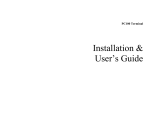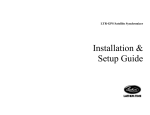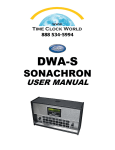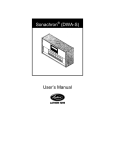Download Precision Power PC400.4 User`s guide
Transcript
PC400 & PC400TX Terminal Installation & User’s Guide PayClock, Lathem and the Lathem logo are registered trademarks of Lathem Time Corporation. Other product names mentioned in this manual may be trademarks of their respective companies and are hereby acknowledged. Warning: Changes or modifications to this unit not expressly approved by the party responsible for compliance could void the user’s authority to operate the equipment. NOTICE: This equipment has been tested and found to comply with the limits for a digital device, pursuant to Part 15 of the FCC Rules. These limits are designed to provide reasonable protection against harmful interference when the equipment is operated in a commercial environment. This equipment generates, uses, and can radiate radio frequency energy and, if not installed and used in accordance with the instructional manual, may cause harmful interference to radio communications. Operation of this equipment in a residential area is likely to cause harmful interference in which case the user will be required to correct the interference at his or her own expense. FOR UNITS EQUIPPED WITH AN INTERNAL MODEM NOTICE: This equipment has been tested and found to comply with the limits for a digital device, pursuant to Part 15 of the FCC Rules. On the mounting panel of this equipment is a label that contains, among other information, the FCC Registration Number and Ringer Equivalence Number (REN) for this equipment. If requested, provide this information to your Telephone Company. The registration jack USOC for this equipment is (RJ-11). An FCC compliant telephone cord and modular plug is provided with this equipment. This equipment is designed to connect to the telephone network or premises wiring using a compatible modular jack, which is Part 68 compliant. See installation instructions for details. The REN is useful to determine the quantity of devices that may be connected to the telephone line. Excessive RENs on the telephone line may result in the devices not ringing in response to an incoming call. In most, but not all areas, the sum of “REN” of all devices should not exceed five (5). To be certain of the number of devices that may be connected to a line, as determined by the total “REN”, contact the local Telephone Company. If your telephone equipment (Modem) causes harm to the telephone network, the Telephone Company will notify you in advance that temporary discontinuance of service may be required, but if advance notice isn’t practical, you will be notified as soon as possible. You will be advised of your right to file a complaint with the FCC if you believe it is necessary. Your Telephone Company may make changes in its facilities, equipment, operations or procedures that could effect the operation of your equipment. If they do, you will be given advance notice so as to give you an opportunity to maintain uninterrupted service. If you experience trouble with this equipment (Modem), please contact Lathem Time Customer Service at (404)-691-1065 for repair/warranty information. If your equipment is causing harm to the telephone network, the Telephone Company may request that you disconnect the equipment until the problem is resolved. A Lathem-Authorized Service Center will replace a defective Lathem Modem product. This equipment may not be used on public coin service provided by the Telephone Company. Connection to party lines is subject to state tariffs. (Contact your state public utility commission or corporation commission for information.) NOTICE: The Industry Canada label identifies certified equipment. This certification means that the equipment meets certain telecommunications network protective, operational and safety requirements. The Industry Canada does not guarantee the equipment will operate to the user’s satisfaction. This equipment meets the applicable Industry Canada Terminal Equipment Technical Specifications. This is confirmed by the registration number. The abbreviation, IC, before the registration number signifies that registration was performed based on a Declaration of Conformity indicating that Industry Canada technical specifications were met. It does not imply that Industry Canada approved the equipment. Before installing this equipment, users should ensure that it is permissible to be connected to the facilities of the local Telecommunications Company. This equipment must also be installed using an acceptable method of connection. In some cases, the company’s inside wiring associated with a single line individual service may be extended by means of a certified connector assembly (telephone extension cord). The customer should be aware that compliance with the above conditions may not prevent degradation of service in some situations. Repairs to this equipment can be handled by: Lathem Time Corp. 200 Selig Drive SW, Atlanta, GA 30336 Any equipment repairs made by the user, or equipment malfunctions, may give the Telecommunications Company cause to request the user to disconnect the equipment. Users should ensure, for their own protection, that the electrical ground connections of the power utility, telephone lines and internal metallic water pipe system, if present, are connected together. This precaution may be particularly important in rural areas. Caution: Users should not attempt to make such connections themselves, but should contact the appropriate electric inspection authority, or electrician, as appropriate. NOTICE: The Ringer Equivalence Number (REN) for this terminal equipment is 0.3. The REN assigned to each terminal equipment provides an indication of the maximum number of terminals allowed to be connected to a telephone interface. The termination of an interface may consist of any combination of devices subject only to the requirement that the sum of the Ringer Equivalence Numbers of all the devices does not exceed five. Support Information Lathem offers technical support on a per incident basis. Calls for support after the first 30 days are chargeable per incident. Support Agreements are available that enable you to unlimited technical support, no charge upgrades and next day shipment of replacement hardware depending on the Agreement selected. When calling Lathem for technical support, please have the software version number, serial number, and support agreement number or credit card number if not covered by a support agreement and details of the problem ready to give to the support agent. Getting Help If you need help with your PayClock, there are several ways to find answers to your questions: 1) consult the on-line help in your software, 2) check the Troubleshooting section in this manual or 3) contact Lathem’s technical support group. To reach Lathem technical support group through the Internet, go to www.lathem.com/support.aspx and click on the link to Technical Support. Support Agreements Lathem offers a hassle-free support agreement for your peace of mind. You can call our sales department for more details and pricing on this support plan. With the Support Plan Unlimited telephone support Free software updates and version upgrades We send you an exchange clock next day shipping if yours goes down or is damaged Repairs on faulty parts and workmanship Without the Support Plan Calls for support after the first 30 days from purchase are billed for each incident You must purchase any software upgrades You must send in your clock for repair After the standard warranty period, charges apply for repairs to damaged or defective parts Lathem Time Corporation 200 Selig Drive SW Atlanta, GA 30336 404-691-0405 Document Number USG0037I CONTENTS WELCOME.....................................................................................................................................1 FEATURES AND SPECIFICATIONS ....................................................................................................1 IMPORTANT FIREWALL SOFTWARE NOTICE ...................................................................................2 MOUNT THE CLOCK ..................................................................................................................4 CONNECT THE COMMUNICATION CABLES ......................................................................7 RS-232 CONNECTIONS ..................................................................................................................7 RS-485 CONNECTIONS ..................................................................................................................8 MODEM CONNECTIONS (OPTIONAL)...............................................................................................9 PC400TX TCP/IP CONNECTIONS (OPTIONAL) ............................................................................10 BELL RELAY CONNECTIONS ........................................................................................................11 SETUP THE CLOCK ..................................................................................................................12 STARTING THE TERMINAL SETUP MODE ......................................................................................12 Terminal Setup Mode..............................................................................................................13 PIN Entry SetupMode .............................................................................................................14 USING THE CLOCK...................................................................................................................15 To punch using a badge ..........................................................................................................15 To use PIN entry .....................................................................................................................15 To transfer ..............................................................................................................................16 To enter amounts ....................................................................................................................16 To see benefit time balance/ accumulated hours for the pay period.......................................16 To see the Terminal Status......................................................................................................17 SUPERVISOR MODE......................................................................................................................17 Schedule Override...................................................................................................................17 Manual Bell Ring ....................................................................................................................18 Setting up badges that can activate the Supervisor Mode ......................................................18 WIRING DIAGRAMS .....................................................................................................................19 RS-232 TO HOST .........................................................................................................................19 RS-485 NETWORK .......................................................................................................................20 MULTI DROP NETWORK USING THE SWIFT485+ ........................................................................20 PC400 TERMINAL BLOCK DIAGRAM ...........................................................................................21 INSTALLING A MODEM MODULE IN THE PC400...........................................................................22 INSTALLING A TCP/IP MODULE IN THE PC400............................................................................24 REPLACING AN EXISTING PAYCLOCK 2000 OR PC100 ................................................................26 TROUBLESHOOT THE CLOCK........................................................................................................28 PC400 Terminal Installation & User’s Guide - 1 CHAPTER 1 Welcome Reliability, functionality and ease of use are trademarks of the PayClock terminals. With the PC400 terminal, employees use their Lathem ID badges to punch in and out, view messages or benefit time balances – it’s that simple. Using Lathem time and attendance software and your computer, PayClock terminals are the perfect solution for businesses that want to track employee time and automate payroll. IMPORTANT ¾Windows 2000 or XP or later is required when using the PC400TX terminal(s) ¾PayClock Pro version 4.0 or later is required when using the PC400TX terminal(s) ¾If you are using firewall software, see the Important Firewall Software Notice below. Features and Specifications Display: Clock: 4 Line x 20 Character back-lit LCD dot-matrix display 12 or 24 hour-format, USA or International, quartz-precision TimeStamp on data transactions Indicators: Audible and LED’s indicate Valid registration (green) single beep and Invalid registration (red) double beep. Communications: Single or multi-clock environments, both local and remote via EIA Standard RS-232 or RS-485 cable connections, Hayes Standard compatible modem (optional) or TCP/IP ETHERNET 10-base-T compatible (optional). Input: Keypad and mag-stripe slot reader. Badges are mag-stripe format ABA Track-2 Casing: Molded plastic housing with steel back box. 7.10” wide x 7.75” high x 3.40” deep; weight 2.75 pounds. 16-button keypad Power: Terminal - 7v-9v, AC/DC @ 1 amp Source - Wall Adapter/Transformer Input: 120 VAC 60Hz 12W Output: 9.0 VAC 1A Relay: “Dry” for 2.0amps @ 24VDC or 1.0 amp @120VAC Environment: Operation: 32° to 110° F (0° to 43° C) 2 - PC400 Terminal Installation & User’s Guide Certification: UL, cUL, FCC Part -15 and FCC Part -68 (when equipped with optional internal modem) Cable Specs: Note: All cables must conform to local building/electrical codes. Consult a qualified installer. RS232 – Data communications cable. Approved maximum length 50 feet. Connect at the computer with a DB9 (female) connector and RJ45 connector at the terminal RS485 – Unshielded Twisted Pair (UTP) data communications cable (Category 3 or Category 5) Maximum cable run of 4,000 feet Employees 500 (per terminal) Departments 100 (per terminal) Transactions 4,600 The PC400 supports firmware patches that download from the PayClock software. The PayClock software allows the user to get firmware patches from the Lathem web site. Then when you poll or update the PC400 the patch will automatically be installed. Note: For more information on installing firmware patches see the PayClock on line help. Capacities: Firmware Upgrades: Note about Lithium Battery This product’s lithium battery contains Perchlorate Material – special handling may apply. Please go to web site www.dtsc.ca.gov/hazardouswaste/perchlorate for information about proper methods of disposal in California. Power Surges and Spikes Any time your terminal is connected to AC current, a power surge or spike can occur. You should use high quality surge suppressers to protect your PC400. The warranty does not cover damage caused by power surges or spikes. Important Firewall Software Notice If you are using firewall software, you may need to unblock or allow access to a number of PayClock Version 4 application files. The PayClock Version 4 installation automatically exposes the typical application (*.exe) files if you are using the Windows XP Service Pack 2 built in firewall. Note: When we configure PayClock Version 4 in the Windows XP Service Pack 2 built in firewall, we do not open specific ports. Instead we expose the application (*.exe) file. This insures that the necessary available ports will be open when needed. PC400 Terminal Installation & User’s Guide - 3 Here is a list of the applications and their corresponding application executables: Main Application Files BADGEX.EXE Badge Excluder Utility BELL.EXE Bell Ringing Setup Wizard BT32SMGR.EXE Database Service** BTENG32M.EXE Database Manager** DIALIN.EXE Dial In Manager Wizard DBMGR.EXE Database Manager User Interface** EMPREPORTS.EXE Employee Reports Setup Utility** EXPORT32.EXE Export Engine** IMPORT.EXE Data Import Utility LICMGR32.EXE Licence Manager** LRSEDIT.EXE Langage Editer Utility MAPDB.EXE Database Connection Object Utility** MERGE.EXE File Merging Utility MSGCHECK.EXE Message checker** PCCLICK.EXE PC Click User Interface** PCIHSV.EXE Interactive Help** PCSCMGR.EXE Server Manager User Interface** RBEDIT.EXE Raw Registration Editor** REGISTER32.EXE Registration Wizard** RENY.EXE Startup Manager** RENYRUN.EXE PayClock Base Module** REPWRITE.EXE Report Manager Interface** SETDST.EXE Custom Daylight Savings Setup Utility TERMMGR.EXE Terminal Manager** **Automatically exposed for the Windows XP Service Pack 2 built in firewall. 4 - PC400 Terminal Installation & User’s Guide CHAPTER 2 Mount the Clock Find a suitable location where: Temperature stays within 32°-110° F Humidity remains below 95% No excessive vibrations are present An electrical outlet is within 4 feet Note: Exposure to outdoor conditions, rain, snow, etc voids the warranty. Wall Mount - To install the back box ♦ Locate a flat wall surface. Place the back box on the wall 48 inches from the floor, with a pencil trace the outline where the 3 holes will be drilled. Raised Strain Relief Points. To use these, slide the tie wrap through the raised slot(s) and secure around cable and power cord. Figure 1 Figure 1 Alternative Mounting: Install the back box directly to an electrical box. PC400 Terminal Installation & User’s Guide - 5 Note: The PC400 back box is designed to align with mounting holes if you are replacing a PC2000, PC1000 or PC100 terminal. ♦ Drill the 3 holes noted using a 5/16” drill bit. ♦ Insert a wall anchor (not included) in each hole and tap with a hammer until flush with the wall. ♦ Align the back box with the anchors, insert the 3 screws and tighten with a Phillips head screwdriver; see Figure 1. ♦ Remove one of the back box knockouts, so you can run the communication cable and 9VAC power pack cable to the clock. ♦ Secure the power and communications cable to the back box by inserting supplied Tie Wrap(s) through the raised strain relief points. ♦ Align the slots on the back of the clock with the tabs on the top of the back box. Plug in the power pack and communications cable, and then lower the clock into place. ♦ Turn the key and lock the clock in place. Note about the PC400TX The PC400TX may be located at any point within a TCP/IP Ethernet 10-Base-T network, as long as the section of cable between the network switch and PC400TX does not go beyond three hundred and twenty eight (328) wire-feet. A typical topography for the PC400TX in an Ethernet 10-Base-T network is a star configuration. NOTE: It is recommended that the PC400TX be plugged into a switch. 6 - PC400 Terminal Installation & User’s Guide Desktop Mount - To install the back box ♦ Locate a flat surface. Make sure you can plug the terminal into a 110VAC wall outlet (220VAC in Europe and other areas), which should be no farther than 4 feet from the terminal. ♦ Remove one of the back box knockouts, so you can run the communication cable and 9VAC power pack cable to the clock. ♦ Rotate the back box as illustrated below. Secure the power and communications cable to the back box by inserting supplied Tie Wrap(s) through the raised strain relief points; see Figure 2. ♦ Align the slots on the back of the clock with the tabs on the back box. Plug in the power pack and communications cable, and then lower the clock into place. ♦ Turn the key and lock the clock in place. Note: Install rubber feet (not included) on bottom of back box to prevent marring of the desktop. Raised Strain Relief Points. To use these, slide the tie wrap through the raised slot(s) and secure around cable and power cord. Figure 2 PC400 Terminal Installation & User’s Guide - 7 CHAPTER 3 Connect the Communication Cables RS-232 Connections You can connect one clock to the host computer with an RS-232 connection. This is a basic connection using an RS232 serial cable. See Appendix A for the RS232 cable diagram To make an RS232 connection ♦ Run your RS-232 cable from the back of the computer to the clock. ♦ Attach the DB9 connector to an open 9-pin COM port on the back of your computer. (Note: Connect the RJ45 modular cable to the DB9/RJ45 adapter) ♦ Insert the RJ-45 end of the cable through one of the knockouts on the clock’s back box. ♦ Attach the RJ-45 plug to the Terminal’s RS232/RS485 communications port as shown in the diagram below, Figure 3. Figure 3 RS232 / RS485 Port 8 - PC400 Terminal Installation & User’s Guide RS-485 Connections An RS-485 connection can attach up to 31 clocks to the computer, using a SWIFT-485+ converter that you can purchase from Lathem. You can wire the clocks directly to the converter (star configuration) or wire them to RS485 Terminal Screws; this allows you to run in a single line starting from the converter (multi-drop configuration). With an RS-485 connection, you can use up to 4000 feet of cable to connect your clocks to the computer. Lathem recommends using CAT 5-UTP (unshielded twisted pair) data transmission cable. To make an RS485 connection ♦ Connect a SWIFT-485+ converter to an open COM port on your computer. If your COM port has 25 pins, you will need a 9-to-25 pin adapter that you can buy from a computer store. ♦ Run the CAT 5 cable from the Swift-485+ to the first clock in the series . See Appendix A for the RS485 Network diagram ♦ Unplug the RS485 screw terminal connector and attach a matched pair from your cable as shown in the diagram, plug in the connector. Make sure that the polarity is maintained. If your cable is terminated with a RJ-45 plug connect to the Terminal’s RS232 / RS485 communications port as shown in the diagram below, Figure 4. (-)(+) RS485 Screw Terminal Connector RS232/RS485 Port Figure 4 PC400 Terminal Installation & User’s Guide - 9 Modem Connections (optional) A PC400 with the modem module allows your computer to call the PC400 or the PC400 can call the computer and communicate through the telephone line as if directly connected. It is recommended that remote terminals be connected to a dedicated phone line with no other devices attached to it unless the terminal will be dialing out to the host computer. The internal PayClock modem modules are analog devices and you should not use them with a digital telephone (PBX) system. Improper connections void your warranty and can damage your clock. Note: Use the Terminal Manager software to setup a PC400 to call the computer and when setting the number of rings to answer. See the Terminal Manager help for details. See Appendix C for the directions on installing a modem module in the field. To make a Modem connection ♦ Connect a standard phone line to a nearby analog phone jack. ♦ Insert the other end of the phone line through a knockout in the terminal back box and plug it into the clock’s modem connection port as shown in the diagram below, Figure 5. Modem Connection Port Figure 5 10 - PC400 Terminal Installation & User’s Guide PC400TX TCP/IP Connections (optional) For Ethernet communications, CAT 4 or 5 unshielded twisted pair high-speed data communication cable is recommended. A standard Ethernet cable should be used, unlock and remove the terminal from the mounting bracket. Route the cable through the desired knockout of the mounting plate and plug the RJ45 plug into the Ethernet Communication port as shown below See Appendix D for the directions on installing a 10Base T module in the field. To make a TCP/IP connection ♦ Connect a standard Ethernet cable to the network switch. ♦ Insert the other end of the standard Ethernet cable through a knockout in the terminal back box and plug it into the clock’s Modem/10 Base T connection port as shown in the diagram below, Figure 5. Modem / 10 Base T Connection Port Figure 5 PC400 Terminal Installation & User’s Guide - 11 Bell Relay Connections With the bell relay, you can program when bells or other devices will ring using the Bell Wizard in your Terminal Manager software. You should have a qualified/certified electrician connect your signaling devices to ensure proper connections and prevent damage to your equipment. To connect your signaling device(s) power source Unplug the bell relay screw terminal connector and connect your wires from the signaling device(s) power source to the “Common” and “Normally Open” screw terminals, plug in the connector. See the diagram, Figure 6 and IMPORTANT! note below. Common Normally Open Normally Closed (Not Used) Bell Relay Screw Terminal Connector Maximum of 4 Bells / Horns IMPORTANT! Relay contacts provide no power for bells or buzzers. They are rated “dry” for 2.0 amps @ 24 VDC or 1.0 amp @ 120 VAC. Connecting a device or series of devices that draw more than the appropriate amperage from the terminal will result in serious damage! We recommend using the RB8 Relay Booster Box to control devices that require more than 2 amps. Contact your dealer for information about obtaining an Figure 6 When connecting directly to 120vAC. See Important note to the left for details. 120vAC PC400 Bell Relay Screw Terminal Connector 12 - PC400 Terminal Installation & User’s Guide CHAPTER 4 Setup the Clock You must power up and configure each clock when you install it. You can do this through the terminal setup mode. Note: The set up of the PC400 and PC400TX are the same. Starting the Terminal Setup Mode The terminal must first go through its power - up test before you can start the setup mode. After the power - up test completes the terminal will display “All Systems OK”. To power up the clock ♦ With the terminal’s 9VAC power supply plugged into an electrical outlet, plug the other end into the terminals power connector; see the diagram below, Figure 7. Power Connector Figure 7 ♦ The terminal goes through the power up test, beeps and the lights flash. PC400 Terminal Installation & User’s Guide - 13 Note: The first time the PC400/PC400TX is powered up it will go into the Terminal Setup Mode automatically. Terminal Setup Mode Use the terminal setup mode to set the time, date, baud rate and terminal ID # for the terminal. *NOTE* You can exit the terminal setup mode at any time by pressing the [*] Exit key. To start the Terminal Setup Mode ♦ Press 729255 on the keypad to enter the “Terminal Setup” function. The terminal displays ENT.DATE: MM-DD-YYYY Enter the current date and press # [enter]. The terminal displays ENTER DAY-OF-WEEK: D 1=SUNDAY..7=SATURDAY Enter the number that represents the current day of the week. The terminal displays ENTER TIME: HH:MM Enter the current time and press # [enter]. The terminal displays SELECT [0] PM / [1] AM Press 0 to select PM or 1 to select AM. The terminal displays PRESS [#] IF CORRECT Press # [enter]. The terminal displays COMMUNICATIONS SETUP SELECT BAUD RATE: [2]400 -OR- [9]600 Press 2 to select 2400 or 9 to select 9600 (required for PC400TX). The terminal displays ENTER TERM ID# 049 (049 is the default setting) Enter the number for the terminal ID and press # [enter] and then press # [enter] again. Note: Valid ID’s are 1 – 250 excluding 58. The terminal will go to the normal time and date display 14 - PC400 Terminal Installation & User’s Guide PIN Entry SetupMode The PIN Entry Setup Mode allows you to enable or disable PIN entry from the keypad. PIN entry enables your employees to key in their badge number when punching instead of swiping their badge. With PIN entry enabled employees can do either, swipe their badge or key in their badge number. To Enable PIN entry press 752902 on the keypad. To Disable PIN entry press 752902 on the keypad. Note: The 752902 code toggles PIN entry on or off. If you disable PIN entry, press [*] after the last digit is entered to return to a normal display Press the Status button on the keypad to check your settings, this screen will display When PIN entry is enabled this screen will display: PIN ENAB. When PIN entry is disabled this screen will display: PIN DISAB VER ID# MEM UPD LOAD LIST or CLK READY use BAUD PIN DST Firmware version of your clock Number used to identify your clock Percentage of memory used Identifies the firmware patch version Ready to be updated from the PayClock software Clock has been updated from the PayClock software and is ready to Baud rate setting 9600 or 2400 ENAB = enabled / DISAB = disabled ON= Daylight savings is on / OFF = Daylight savings is off This completes the setup. The terminal is ready to accept a download. For more information on downloading to the PC400/PC400TX see the PayClock software users guide or the on line help. Note: If your PC400TX was discovered and configured using the Terminal Manager software you will see the terminals IP address display after the above Status screen. PC400 Terminal Installation & User’s Guide - 15 CHAPTER 5 Using the Clock At the PC400/PC400TX series clocks, employees can punch in and out, transfer, enter amounts, view messages and punch information. They can do this by swiping their badge or by using the PIN entry feature. PIN entry allows the employee to key in their badge number at the keypad. PIN entry must be enabled to use the PIN entry feature. To punch using a badge The PC400/PC400TX series clocks have a magnetic stripe badge reader. The stripe should be on the left side of the badge when swiping. To swipe the badge, insert it at the top of the reader, then pull it down with a continuous and smooth motion; see Figure 8. Figure 8 After the employee has punched the grand totals for the pay period will display as well as any message that has been sent to the employee. Note: The grand totals display can be turned on or off from within Terminal Manager. See the Terminal Manager help for details. For more information on sending messages to employees see the PayClock online Help. To use PIN entry With the time and date showing on the display, press the “0” key, the screen will display “ENTER PIN:” key in your badge number and press [#] enter. Note: If the time and date are not showing on the display press *[exit] on the keypad, then press the “0” key. 16 - PC400 Terminal Installation & User’s Guide To transfer ♦ ♦ ♦ Press Transfer Swipe your badge or PIN your badge number and press # [enter] Key in the department number for the transfer or press the ♦ ♦ button to scan up the list of departments or press the button to scan down the list of departments Press # [enter] Press # [enter] To enter amounts ♦ ♦ ♦ ♦ ♦ Press Amount Swipe your badge or PIN your badge number and press # [enter] Key in the dollar amount Press # [enter] Press # [enter] To see benefit time balances and accumulated hours for the pay period ♦ Press Inquiry ♦ Swipe your badge or PIN your badge number and press # [enter] ♦ The benefit time balance and total hours display Note: Select the benefit time counter(s) to display from the Options tab at the Terminal Properties. Up to 2 benefit time counters can be set up. To have the grand totals for the pay period not display, uncheck the option “Show Grand Totals at Terminal during Punching”. See the Terminal Manager help for details. PC400 Terminal Installation & User’s Guide - 17 To see the Terminal Status ♦ ♦ Press Terminal Status The status screen displays Supervisor Mode Two supervisor modes are available for your PC400/PC400TX. You can override a lockout schedule and manually close the bell relay. Schedule Override With a supervisor badge, you can temporarily disable any lockout schedules set for the terminal, allowing the terminal to read the next badge that is entered. This provides supervisors a way to override a lockout schedule in special situations. Before starting, be sure that the PC400/PC400TX is in normal operation mode with the time of day and date showing on the display. Otherwise, press * [exit] to resume normal operation. To override a lockout zone for an employee In/Out punch: 1. With the time and date showing press # [enter], swipe your supervisor badge 2. “Supervisor Mode” with show on the terminal display 3. Within 5 seconds have the employee swipe their badge or PIN their badge number and press [#] enter To override a lockout zone for an employee department transfer: 1. With the time and date showing press # [enter], swipe your supervisor badge 2. “Supervisor Mode” with show on the terminal display 3. Press the department transfer button 3 times 4. Within 5 seconds have the employee swipe their badge or PIN their badge number and press [#] enter 5. Key in the department number for the transfer 6. Press # [enter] 7. Press # [enter] Note: Amount entries are allowed during a lockout schedule. 18 - PC400 Terminal Installation & User’s Guide Manual Bell Ring With a supervisor badge, you can manually close the bell ringer relay. This function could be used for fire drills or to test the bell circuit. To manually close the bell ringer relay: 1. Press # [enter], swipe your supervisor badge 2. “Supervisor Mode” with show on the terminal display 3. Within 5 seconds press 1 and then 1 again on the keypad, the relay will close and activate the bell or buzzer for approximately 3 seconds. If you press 1 again within 5 seconds, the relay will close again. This can be repeated as many times, as you like. Setting up badges that can activate the Supervisor Mode y While in Terminal Manager open the PC400 Terminal Properties, from the Options tab select up to 4 employees that will be able to make supervisor overrides at the terminal. y Update the PC400/PC400TX terminal. The PC400/PC400TX terminal will now accept the selected badge(s) as a supervisor badge. For more information, see the Terminal Manager on line help. PC400 Terminal Installation & User’s Guide - 19 APPENDIX A Wiring Diagrams RS-232 to Host DB9/RJ45 ADAPTOR 20 - PC400 Terminal Installation & User’s Guide RS-485 Network Multi Drop Network using the SWIFT485+ PC400 Terminal Block PC400 Terminal Block PC400 Terminal Block Note: When replacing a PC2000 RS485 terminal with a PC400, you can connect the PC400 terminal using the existing J-Kit. Simply plug in the cable that goes from the junction box to the terminal into the RS232/485 RJ45 communication port. See Appendix D Replacing an Existing PC2000 or PC100 PC400 Terminal Installation & User’s Guide - 21 APPENDIX B PC400 Terminal Block Diagram Power Connector Bell Relay Fuse (1amp slow blow) Modem/ 10BaseT Connection Bell Relay Screw Terminals Common RS232 / RS485 Connection Normally Open Normally Closed (-) (+) RS485 Screw Terminals 22 - PC400 Terminal Installation & User’s Guide APPENDIX C Installing a Modem Module in the PC400 IMPORTANT: Follow these 2 steps before starting the internal modem installation 1. Disconnect the power from the PC400. 2. Discharge any static in your body by touching a large metal object ¾ Remove the PayClock 400 Terminal from the Back Box 1. Unlock and remove the terminal from the back box. Place the terminal on a comfortable workspace. 2. Using a Philips screwdriver, remove and save the 4 Philips head screws at each corner of the internal cover plate of the PayClock terminal; see Figure 9 3. Remove and discard the modem cover plate, then remove the internal cover plate; see Figure 9. ¾ Install the Modem Module 4. Carefully plug the Modem Module into the empty socket at the U16 location on the circuit board; see Figure 10. 5. Replace the internal cover plate and install the 4 Philips head screws. Do not install the modem cover plate. 6. Align the tabs on the back box with slots at the top of the internal cover plate. Plug in the power cable and modular phone cable. Then lower the terminal into place. 7. Turn the key to lock the terminal onto the back box. ¾ Setup the Terminal 8. Enter the Terminal Setup Mode by pressing 729255 on the keypad. Set the date, day of week, time, baud rate (9600) and terminal ID. 9. From the PayClock software update the terminal. PC400 Terminal Installation & User’s Guide - 23 Internal Cover Plate Cover Plate Figure 9 Circuit Board Assembly Pin - 1 Position the modem module so Pin-1 will be inserted into the bottom socket on the lower right hand corner of the CPU board. PC400 Modem Figure 10 24 - PC400 Terminal Installation & User’s Guide APPENDIX D Installing a TCP/IP 10Base T Module in the PC400 CAUTION: Follow these 2 steps before installing the 10Base T module installation 1. Disconnect the power from the PC400. 2. Discharge any static in your body by touching a large metal object NOTE: This 10Base T upgrade requires firmware version 3.05 or later and circuit board revision K or later. ¾ Remove the PayClock 400 Terminal from the Back Box 1. Unlock and remove the terminal from the back box. Place the terminal on a comfortable workspace. 2. Using a Philips screwdriver, remove and save the 4 Philips head screws at each corner of the internal cover plate of the PayClock terminal; see Figure 9 3. Remove and discard the modem cover plate, then remove the internal cover plate; see Figure 11. ¾ Install the 10Base T Module 4. Carefully plug the 10Base T module into the empty socket at the U26 location on the circuit board; see Figure 11. 5. Replace the internal cover plate and install the 4 Philips head screws. Do not install the modem cover plate. 6. Align the tabs on the back box with slots at the top of the internal cover plate. Plug in the power cable and Ethernet cable. Then lower the terminal into place. 7. Turn the key to lock the terminal onto the back box. ¾ Setup the Terminal 8. Enter the Terminal Setup Mode by pressing 729255 on the keypad. Set the date, day of week, time, baud rate (9600) and terminal ID. PC400 Terminal Installation & User’s Guide - 25 Figure 11 26 - PC400 Terminal Installation & User’s Guide APPENDIX E Replacing an Existing PayClock 2000 or PC100 The PC400 has been designed to easily replace other PayClock terminals in the field. The PC400 back box allows you use the existing mounting holes from your current terminal. Follow these simple instructions when connecting your new terminal. See Figure 12 for details on RS232 and RS485 replacements. Replacing this terminal Using this connection type Replacement Instructions PC2000 RS232 Using the existing communication cable connect the optional PC2000 Cable to PC400 Adapter Kit (#VIE2787) to the DB9 connector that plugged into the PC2000. Plug the RJ45 adapter cable into the PC400. PC2000 RS485 Plug the existing modular cable into the PC400 terminal. Or... Bypass the modular junction box and connect the wires directly to the terminal block on the PC400 terminal as show in Appendix A (Multi drop network using the SWIFT485+) PC2000 Modem Plug the existing modular phone cable into the modem port of the PC400 terminal PC100 RS232 Replace the existing communication cable with supplied cable (#VMM8155) and connect to the computer using the RJ45 to DB9 converter (#VIE2786). PC100R RS485 Plug the existing modular cable into the PC400 terminal. Or... Bypass the modular junction box and connect the wires directly to the terminal block on the PC400 terminal as show in Appendix A (Multi drop network using the SWIFT485+) Replacing a RS-232 PC2000 with a RS-232 PC400 using the adaptor kit part # VIE2787 Replacing PC2000 or PC100R terminals with PC400’s in a RS-485 network PC400 Terminal Installation & User’s Guide - 27 Figure 12 28 - PC400 Terminal Installation & User’s Guide APPENDIX F Troubleshoot the Clock Problem: Terminal does not power up and the display does not appear. Reason: Your power is not connected Solution: Make sure that the power pack is plugged into a live AC outlet. Make sure that the other end of the power pack is plugged into the clock. Problem: When an employee swipes a badge the terminal displays --BADGE ERROR-Reason: Your employee did not swipe the badge properly Solution: The magnetic stripe should be on the left side of the badge when swiping. Insert the badge at the top of the reader, and then pull the badge down with a continuous and smooth motion. Reason: Your employee swiped the badge in the wrong direction Solution: The magnetic stripe should be on the left side of the badge when swiping. Insert the badge at the top of the reader, and then pull the badge down with a continuous and smooth motion. Problem: When I swipe a badge, the terminal does not record the badge and does not signal any errors. Reason: Your employee did not insert the badge properly. Solution: The magnetic stripe should be on the left side of the badge when swiping. Insert the badge at the top of the reader, and then pull the badge down with a continuous and smooth motion. Problem: When an employee swipes a badge the terminal displays --INVALID BADGE-Reason: The terminal has not been updated with the latest employee data Solution: Upload your employees to the terminal. See your software instructions for uploading employee information. PC400 Terminal Installation & User’s Guide - 29 Problem: When an employee swipes a badge the terminal displays --ACCESS DENIED-Reason: The badge is rejected due to the employee’s schedule. Solution: Assign a schedule through the software that will allow the employee to punch at this time. Reason: The badge is rejected due to the employee’s schedule. Solution: Have a supervisor override the schedule lock. See page 15 of this manual. Problem: The terminal is not communicating with the computer Reason: The communication cable is unplugged or defective. Solution: Confirm cable is tested and plugged into both ends (Make sure the cable is wired as outlined in the wiring diagram) Reason: Communication settings for the clock do not match the settings in the software Solution: Refer to the section “Setup the Clock” for setup directions Problem: Occasionally a static discharge causes my terminal to lock up Reason: The terminal is in an area that is subject to abnormally high static discharges Solution: Connect a ground wire to the ground screw (green screw near lock mechanism) on the back box, and then secure the ground wire to the nearest Earth ground. Ground screw and ground wire attached to back box Note: If the closest earth ground is the outlet where the PC400’s power supply is to be plugged in, you may want to use tie wraps to secure the ground wire to the cable of the power supply; see Figure 13 Power Supply Figure 13 If there is a more convenient earth ground location then secure the wire there. 30 - PC400 Terminal Installation & User’s Guide Limited One-Year Limited Warranty Lathem warrants the hardware products described in this guide against defects in material and workmanship for a period of one year from date of original purchase from Lathem or from an authorized Lathem reseller. The conditions of this warranty and the extent of the responsibility of Lathem Time Corporation (“Lathem”) under this warranty are listed below. 1. 2. 3. 4. 5. 6. 7. 8. 9. This warranty will become void when service performed by anyone other than an approved Lathem warranty service dealer results in damage to the product. This warranty does not apply to any product which has been subject to abuse, neglect, or accident, or which has had the serial number altered or removed, or which has been connected, installed, adjusted, or repaired other than in accordance with instructions furnished by Lathem. This warranty does not cover dealer labor cost for removing and reinstalling the machine for repair, or any expendable parts that are readily replaced due to normal use. The sole responsibility of Lathem under this warranty shall be limited to repair of this product, or replacement thereof, at the sole discretion of Lathem. If it becomes necessary to send the product or any defective part to Lathem or any authorized service dealer, the product must be shipped in its original carton or equivalent, fully insured with shipping charges prepaid. Lathem will not assume any responsibility for any loss or damage incurred in shipping. WARRANTY DISCLAIMER AND LIMITATION OF LIABILITY: Except only the limited express warranty set forth above, the products are sold with no expressed or implied warranties of any kind, and the implied warranties of merchantability and fitness for a particular purpose are hereby expressly disclaimed. No warranties are given with respect to products purchased other than from Lathem or an authorized Lathem reseller and any such products are purchased "as is, with all faults." In no event will Lathem be liable for any direct, indirect, special, incidental or consequential damages arising out of or in connection with the delivery, use or inability to use, or performance of this product. In the event any limited remedy given herein shall be deemed to have failed of its essential purpose, Lathem's maximum liability shall be to refund the purchase price upon return of the product. Proof of date of purchase from Lathem or an authorized Lathem reseller is required for warranty service on this product. This Warranty grants specific legal rights. Additional legal rights, which may vary by locale, may also apply. Should any difficulties arise with the performance of this product during warranty, or with any Lathem authorized service centers, contact Lathem Time at the address below. Lathem Time 200 Selig Drive, SW, Atlanta, GA 30336 404-691-0405 www.lathem.com Copyright © 2003 Lathem Time Corporation. All rights reserved. Revised 01-15-2008 Document number: USG0037I Index B Bell Relay Connections, 11 C Connect the Communication Cables, 7 S Setting up Supervisor Badges, 18 Setup Mode, 14 Starting the Terminal Setup Mode, 12 Supervisor Override of Lockout Schedules, 17 Support Agreements, 3 T F Features and Specifications, 1 H Help Support Agreements, 3 I Technical Support, 3 Terminal Setup Mode, 13 To enter amounts, 16 To install the mounting bracket, 4, 6 To punch, 15 To see accumulated hours for the pay period, 16 To see the Terminal Status, 17 To transfer, 16 Troubleshoot the Clock, 28 Installing a Modem Module in the PC400, 22, 24, 26 M Manual Bell Ring, 18 Modem Connections (optional), 9, 10 Mount the Clock, 4 P PC400 Terminal Block Diagram, 21 R RS 232 Connections, 7 RS-232 to Host, 19 RS-485 Connections, 8 RS-485 Network (SWIFT-485+ Converter ), 20 W Wiring Diagrams, 19














































